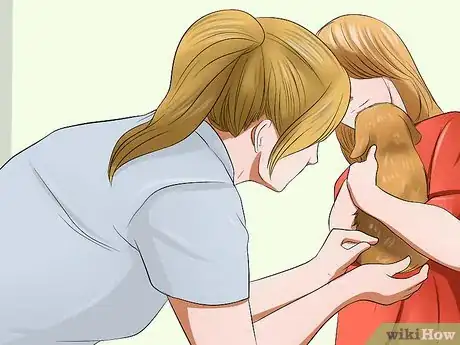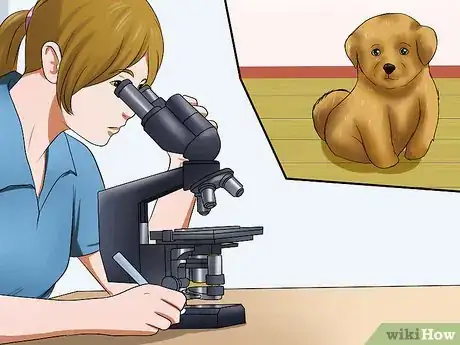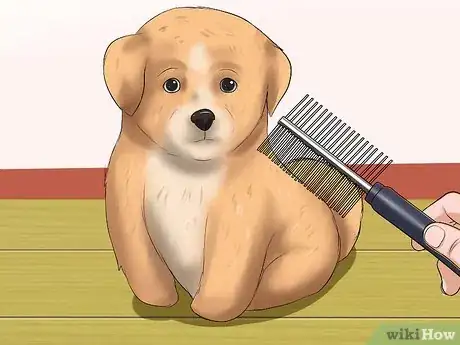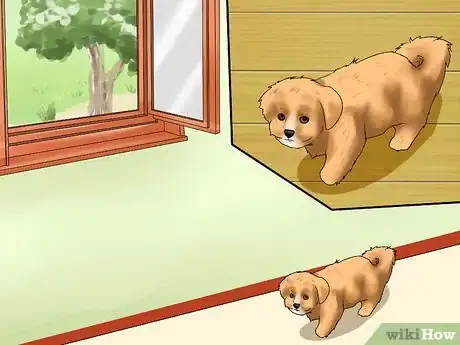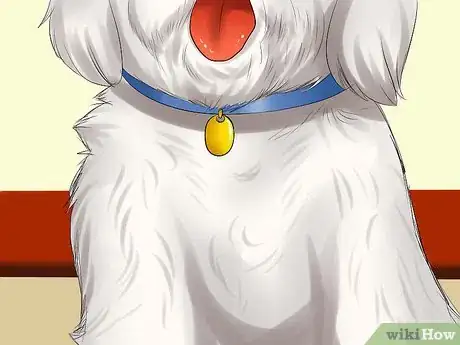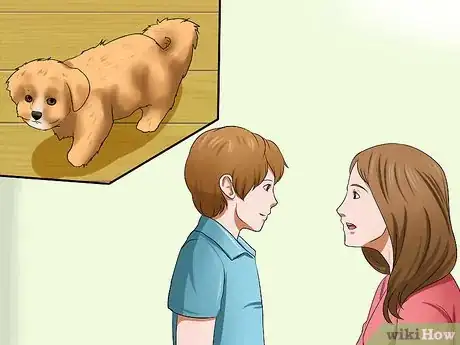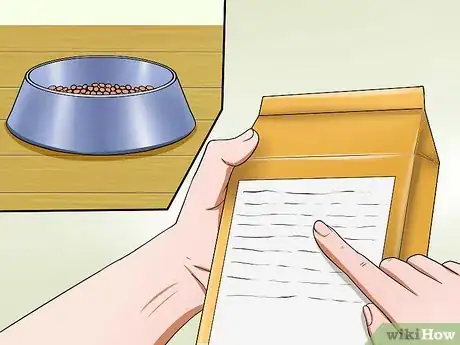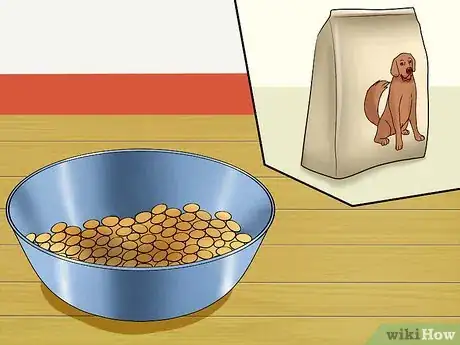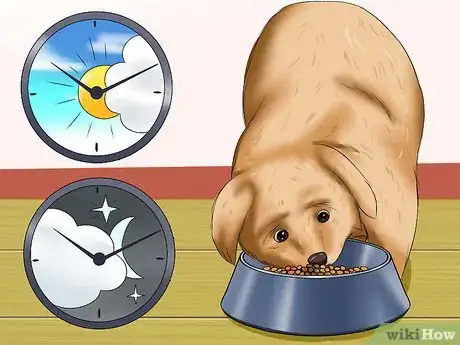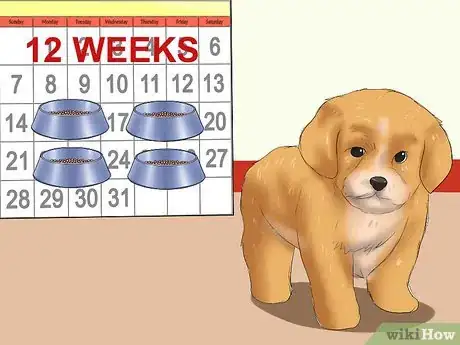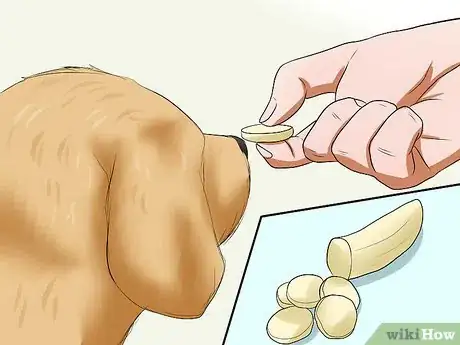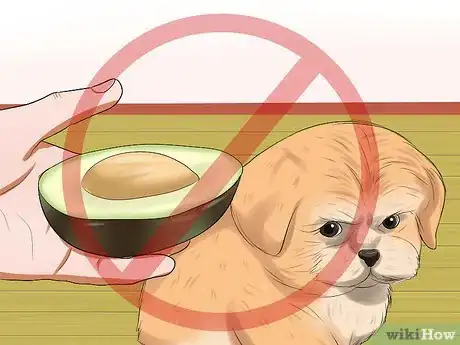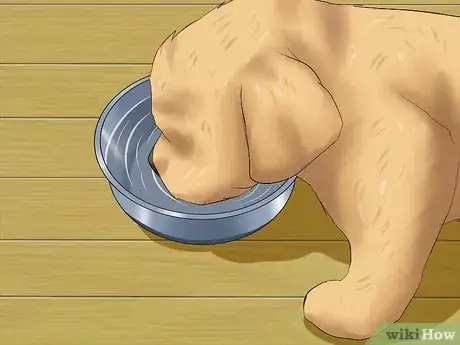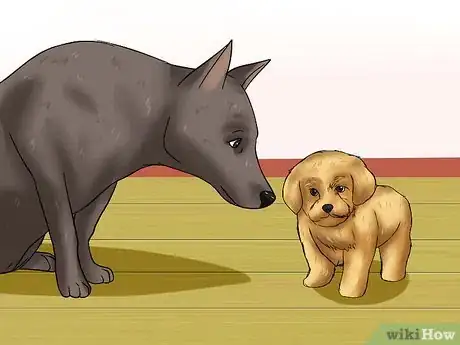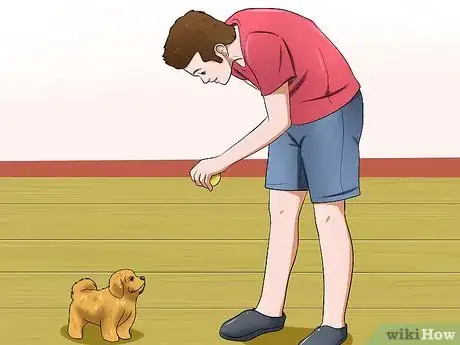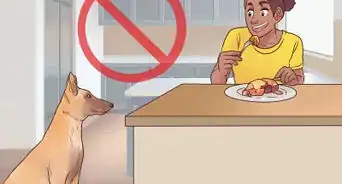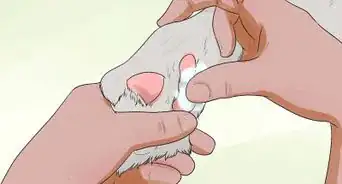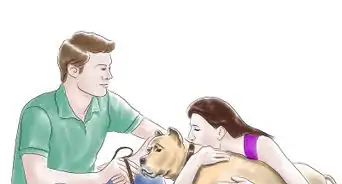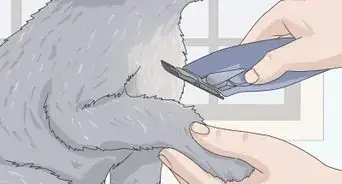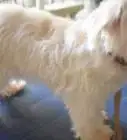This article was co-authored by Brad Greene. Brad is a Certified Professional Dog Trainer (CPDT-KA) and a Fear Free Certified Professional. He is the owner of Fearless Dogs, which is based in the Bay Area of California and has a 5-star rating. Brad specializes in helping clients and their dogs work through challenges using effective and humane behavior change methods, enabling their relationship to thrive. His greyhound, Asher was featured in Greyhound Rescue’s 2022 calendar.
There are 12 references cited in this article, which can be found at the bottom of the page.
wikiHow marks an article as reader-approved once it receives enough positive feedback. In this case, 100% of readers who voted found the article helpful, earning it our reader-approved status.
This article has been viewed 57,078 times.
Maltipoos are a mixed breed with one poodle parent and one Maltese parent. These dogs are often called designer dogs because they were developed to create a dog that combines the best traits of the two breeds. Maltipoos are wonderful family pets and they are great with kids.[1] If you decide to get a Maltipoo, then you will need to provide veterinary care, grooming, food, training, affection, and attention.
Steps
Caring for a Maltipoo’s Health and Safety
-
1Take your Maltipoo for regular veterinary check-ups. As soon as you get your Maltipoo, you will need to make an appointment with your veterinarian. Your veterinarian will need to examine your Maltipoo to ensure that he is healthy and give him a variety of vaccines and preventative medicines. Some of the things that your Maltipoo will probably need include:
- Lyme disease vaccination
- Rabies vaccination
- Heartworm prevention medicine
- Flea and tick prevention medicine
- Spay or neuter operation[2]
- Annual exams and vaccination boosters
-
2Request tests to watch for breed-specific diseases. Some diseases are more common in Maltipoos than in other dogs. You will need to check with your veterinarian to determine what tests your Maltipoo should have each year at his or her annual check-up to screen for these diseases. Maltipoos are more prone to:[3]
- Dental problems due to their small mouth
- Hypoglycemia or low blood sugar
- Patellar (kneecap) luxation
- Collapsing trachea
- Legg-Calve-Perthes Disease
- White shaker dog syndrome
Advertisement -
3Groom your Maltipoo. Since Maltipoos come from parent breeds that require regular grooming, your Maltipoo will also need regular grooming to maintain a healthy coat and to avoid matting and infections. Your Maltipoo will require a visit to the groomer about once every four to six weeks for a trim, so be prepared for this expense. Your Maltipoo’s grooming needs will also include daily brushing, regular bathing, checking ears, trimming nails, and cleaning teeth.[4]
- Brush your Maltipoo’s coat every day. Use swift, firm strokes to brush your Maltipoo’s sides, stomach, back, and chest. Check for fleas, ticks, scabs, lumps, and other skin conditions as you brush. Tell your dog’s veterinarian about anything unusual that you find. Be aware that if your Maltipoo has curlier fur (similar to a poodle) then she will need even more attention to avoid matting.
- Bathe your Maltipoo once per month. You can take your Maltipoo to a groomer for a bath or do it yourself.
- Clean your Maltipoo’s ears. Look for any wax buildup, discharge, or foul odors. You can clean out your Maltipoo’s ears with a small piece of damp (not wet) cotton gauze wrapped around your finger.
- Clip your Maltipoo’s nails once per month. Use a guillotine style trimmer or a grinder to trim your Maltipoo’s nails. Just be careful not to hit the quick, which is a sensitive blood vessel inside of your Maltipoo’s nail. Trim only a little at a time to avoid the quick.
- Clean your Maltipoo’s teeth daily. You will need to use a dog toothbrush and toothpaste meant for dogs. Human toothpaste will make your dog sick. Start by letting your Maltipoo lick some wet dog food off of the toothbrush a few times and then try brushing your dog’s teeth.
-
4Keep your Maltipoo indoors. Maltipoos are indoor dogs. Keeping your Maltipoo outside will expose her to the elements, predators, and dog thieves. Since Maltipoos are designer dogs that often cost a lot of money, an unattended Maltipoo can be an attractive target for dog thieves.
- Make sure that you keep your Maltipoo indoors as much as possible and supervise her whenever she needs to go out.
- Give your Maltipoo a soft, comfortable bed to sleep in. To make your maltipoo even more comfortable, you may want to provide a soft bed for your dog. You can purchase a special dog bed or use some old (but clean) blankets.
-
5Get a collar and an ID tag for your Maltipoo. If your Maltipoo should ever get out of the yard and wander away from home, a collar and ID tag can help someone to return her home safely to you. Make sure that your Maltipoo is wearing a collar and ID tag at all times.
- You may even want to have your Maltipoo implanted with a microchip to ensure that she can be identified even if she gets lost.[5] '
-
6Teach kids how to handle your Maltipoo. Maltipoos make excellent family pets because they are so even tempered. However, since Maltipoos are such small dogs, they may end up getting mishandled by young children who do not know any better.[6] If you have kids, make sure that you talk to them about how to be gentle with your Maltipoo to avoid hurting him.
- Supervise children around your Maltipoo until you are sure that they know how to handle him with care. If you notice that your child is being too rough with your Maltipoo, then try demonstrating the right way to hold, pet, and play with your Maltipoo. Make sure that you explain why it is important to hold the dog in this way.
Feeding Your Maltipoo
-
1Select a high-quality small breed dog food. Maltipoos require high-quality food to stay healthy. It is also important to choose a food that is appropriate for small breed dogs because food for larger breeds may be difficult for your Maltipoo to chew.
- You can check the ingredients to be sure that the food is high-quality. If meat (not a meat by-product) is one of the first two ingredients, then that dog food is probably high-quality. If not, then look some more.
- Consult a pet nutrition expert if you plan to make your dog’s food. Dogs have specific nutritional needs that are different from what humans require and it can be hard to meet these needs when making your dog’s food yourself.[7] Talk to your veterinarian for advice if you want to cook your dog’s food yourself.
-
2Figure out how much to feed your Maltipoo. Your Maltipoo’s diet depends on his weight and activity level. You can find a suggested range on your dog’s food package, but you will also need to take your dog’s activity level into account when determining how much to feed your Maltipoo.
- For example, your dog’s food package might recommend ½ to one cup of food per day. If your Maltipoo is very active, then he will probably need the higher amount of one full cup of food each day. If your Maltipoo is not active, then he may only need ½ of a cup of food each day.
-
3Develop a regular feeding schedule. Free-feeding is when you leave out a large amount of dry food and allow your dog to eat what he wants whenever he feels like it. This method of feeding is convenient, but it can also cause your dog to become overweight or obese. That is why it is better to give your Maltipoo measured portions at specific times each day.[8]
- Most adult dogs do best if fed twice per day, so you can divide your dog’s total daily intake into two portions and give one in the morning and the other in the evening.
- To determine how much to feed your Maltipoo at each meal, you will need to divide his total daily food intake in half. For example, if your Maltipoo is supposed to have one cup of food every day, then you could give ½ cup in the morning and a ½ cup in the evening.
-
4Consider your dog’s age. Adult dogs do well with two meals per day, but your dog may need to be fed more than twice per day if he is still a puppy. If your puppy is:
- eight to 12 weeks, then divide his food into four portions
- three to six months, then divide his food into three portions
- six months to one year old, then divide his food into two portions[9]
-
5Give your Maltipoo some healthy treats. Treats are a nice way to reward your dog for being good, but the calories can add up and lead to weight gain. To prevent your dog from taking in too many excess calories, try offering:
- blueberries
- watermelon chunks
- banana slices
- cooked sweet potato slices
- broccoli
- baby carrots
- cooked green beans[10]
-
6Prevent your Maltipoo from eating toxic human foods. Maltipoos can also get sick from some foods, so it is important to monitor your Maltipoo’s diet as well. Foods that you should never give your Maltipoo include:[11]
- caffeine
- onions, garlic, and chives
- avocados
- chocolate
- grapes and raisins
- nuts
- alcohol
- yeast
- xylitol[12]
-
7Provide your Maltipoo with plenty of clean, fresh water. Like all dogs, Maltipoos need to have access to a bowl of clean, fresh water at all times.[13] Ceramic or stainless steel bowls are ideal because they do not hold onto as much bacteria as plastic and your Maltipoo cannot chew on them.
- Make sure that you change your Maltipoo’s water every day and replenish it often.
Training and Entertaining Your Maltipoo
-
1Train your Maltipoo to go to the bathroom outside. House training your Maltipoo is one of the most important and also the most difficult things that you will need to do when you first get her. House training involves developing a regular toileting schedule for your dog, cleaning up when your dog has an accident, and praising your dog when she goes to the bathroom outside.
- Try placing some puppy pads or newspaper in a few places around the house in case your Maltipoo has an emergency and you are not around.
- Make sure that you take your dog out after he eats as well as a few more times in between. If you are often gone for long periods, then consider having a neighbor or friend stop by to let your dog out.
- Never yell at your dog, hit your dog, or rub your dog’s face in urine or feces. These methods of house training do not work and they will only frighten and confuse your dog.[14]
- You may also want to consider crate training your Maltipoo. Crate training can help with housetraining and it is also a good way to teach your Maltipoo not to chew on furniture, shoes, and other off-limits items.
-
2Teach your Maltipoo some basic commands. Training your dog is an excellent way to make sure that he is well-behaved and that he listens to you. Training is also a great way to provide some mental stimulation for your dog and it can even serve as a bonding activity. Some good basic commands to teach your Maltipoo include:
-
3Socialize your Maltipoo early. It is important to socialize your Maltipoo so that she will be calm in all sorts of different situations. After your Maltipoo’s first round of vaccinations at about eight weeks old, you can start to socialize her.
- Be sure to expose your Maltipoo to people of all ages, genders, races, and sizes, other dogs, cats, people dressed in unusual attire (hats, raincoats, boots, etc.), loud noises, crowds, and vehicles.
- Always keep your Maltipoo on a leash when you take her out in public.
- Give your Maltipoo lots of praise and petting for being curious and calm around new people and situations.
- If your Maltipoo gets scared, try to reassure her as much as you can or remove her from the situation if she becomes too nervous (trembling, barking, hiding, etc.)
-
4Play with your Maltipoo daily. Your Maltipoo needs lots of love, attention, and affection. You can provide her with these things by remembering to take time to play with your Maltipoo every day. Try heading out in the back yard for a game of fetch each day or take your Maltipoo with you on a walk around the neighborhood.
- Provide fun toys. Maltipoos are smart dogs, so they enjoy toys that will challenge their problem solving skills. Try giving your Maltipoo a variety of interesting toys including puzzle toys, balls, and rope toys.
- Pet your Maltipoo. Sometimes your Maltipoo may just want some affection. Make sure that you pet your Maltipoo every day.
Expert Q&A
-
QuestionDo Maltipoos have health problems?
 Pippa Elliott, MRCVSDr. Elliott, BVMS, MRCVS is a veterinarian with over 30 years of experience in veterinary surgery and companion animal practice. She graduated from the University of Glasgow in 1987 with a degree in veterinary medicine and surgery. She has worked at the same animal clinic in her hometown for over 20 years.
Pippa Elliott, MRCVSDr. Elliott, BVMS, MRCVS is a veterinarian with over 30 years of experience in veterinary surgery and companion animal practice. She graduated from the University of Glasgow in 1987 with a degree in veterinary medicine and surgery. She has worked at the same animal clinic in her hometown for over 20 years.
Veterinarian A hybrid dog like a Maltipoo could develop problems linked to the parent breed. Wobbly kneecaps (luxating patellas) are common to both Maltese and Poodles, so this is perhaps the most likely health issue. Another common problem is maintaining blood sugar levels, as these can fall too low in small breeds that get over hungry.
A hybrid dog like a Maltipoo could develop problems linked to the parent breed. Wobbly kneecaps (luxating patellas) are common to both Maltese and Poodles, so this is perhaps the most likely health issue. Another common problem is maintaining blood sugar levels, as these can fall too low in small breeds that get over hungry. -
QuestionIs a Maltipoo a good family dog?
 Pippa Elliott, MRCVSDr. Elliott, BVMS, MRCVS is a veterinarian with over 30 years of experience in veterinary surgery and companion animal practice. She graduated from the University of Glasgow in 1987 with a degree in veterinary medicine and surgery. She has worked at the same animal clinic in her hometown for over 20 years.
Pippa Elliott, MRCVSDr. Elliott, BVMS, MRCVS is a veterinarian with over 30 years of experience in veterinary surgery and companion animal practice. She graduated from the University of Glasgow in 1987 with a degree in veterinary medicine and surgery. She has worked at the same animal clinic in her hometown for over 20 years.
Veterinarian Yes, the Maltipoo is a dear little soul that makes a great family companion. The only problem is the dog's small size, which can mean they are fragile. Thus, a Maltipoo may be too delicate to be safe around boisterous children.
Yes, the Maltipoo is a dear little soul that makes a great family companion. The only problem is the dog's small size, which can mean they are fragile. Thus, a Maltipoo may be too delicate to be safe around boisterous children. -
QuestionWhat is the life expectancy of a Maltipoo?
 Pippa Elliott, MRCVSDr. Elliott, BVMS, MRCVS is a veterinarian with over 30 years of experience in veterinary surgery and companion animal practice. She graduated from the University of Glasgow in 1987 with a degree in veterinary medicine and surgery. She has worked at the same animal clinic in her hometown for over 20 years.
Pippa Elliott, MRCVSDr. Elliott, BVMS, MRCVS is a veterinarian with over 30 years of experience in veterinary surgery and companion animal practice. She graduated from the University of Glasgow in 1987 with a degree in veterinary medicine and surgery. She has worked at the same animal clinic in her hometown for over 20 years.
Veterinarian There's no hard and fast rule here, but the good news is that small dogs live longer. As both parent breeds are small, it's reasonable to predict a life expectancy of 12-15 years
There's no hard and fast rule here, but the good news is that small dogs live longer. As both parent breeds are small, it's reasonable to predict a life expectancy of 12-15 years
Warnings
- Avoid dogs that are being sold online, in newspapers, and at pet stores. These dogs often come from places called “puppy mills.” Puppy mills breed dogs in large quantities for profit and they do not properly socialize their dogs or provide them with good veterinary care. This results in dogs that may be ill-behaved or sick. Purchase your dog from a responsible breeder if you are thinking about getting a dog.⧼thumbs_response⧽
Expert Interview

Thanks for reading our article! If you'd like to learn more about pet caring, check out our in-depth interview with Brad Greene.
References
- ↑ http://www.petguide.com/breeds/dog/maltipoo/
- ↑ https://www.aspca.org/pet-care/general-pet-care/spayneuter-your-pet
- ↑ http://www.embracepetinsurance.com/dog-breeds/maltipoo
- ↑ http://www.vetstreet.com/dogs/maltipoo#grooming
- ↑ https://www.aspca.org/pet-care/general-pet-care/finding-lost-pet
- ↑ http://www.vetstreet.com/dogs/maltipoo#overview
- ↑ https://www.aspca.org/pet-care/dog-care/dog-nutrition-tips
- ↑ https://www.aspca.org/pet-care/dog-care/dog-nutrition-tips
- ↑ https://www.aspca.org/pet-care/dog-care/general-dog-care
- ↑ http://pets.webmd.com/dogs/guide/healthy-dog-treats
- ↑ Kahn, C, (2010), The Merck Veterinary Manual, ISBN 978-0911910933
- ↑ https://www.aspca.org/pet-care/animal-poison-control/people-foods-avoid-feeding-your-pets
- ↑ https://www.aspca.org/pet-care/dog-care/dog-nutrition-tips
- ↑ https://www.aspca.org/news/house-training-your-dog-or-puppy
